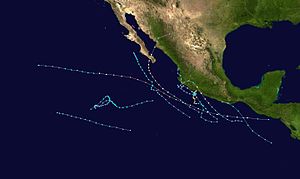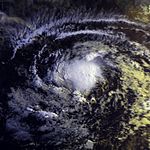1996 Pacific hurricane season
| 1996 Pacific hurricane season | |
|---|---|

Season summary map
|
|
| Seasonal boundaries | |
| First system formed | May 13, 1996 |
| Last system dissipated | November 11, 1996 |
| Strongest storm | |
| Name | Douglas |
| • Maximum winds | 130 mph (215 km/h) (1-minute sustained) |
| • Lowest pressure | 946 mbar (hPa; 27.94 inHg) |
| Seasonal statistics | |
| Total depressions | 14 |
| Total storms | 9 |
| Hurricanes | 5 |
| Major hurricanes (Cat. 3+) |
2 |
| Total fatalities | 41 |
| Total damage | Unknown |
| Related articles | |
| Tropical storm (SSHWS) | |
| Duration | May 13 – May 16 |
|---|---|
| Peak intensity | 50 mph (85 km/h) (1-min) 1000 mbar (hPa) |
| Tropical depression (SSHWS) | |
| Duration | May 15 – May 19 |
|---|---|
| Peak intensity | 35 mph (55 km/h) (1-min) 1006 mbar (hPa) |
| Category 2 hurricane (SSHWS) | |
| Duration | June 20 – June 27 |
|---|---|
| Peak intensity | 105 mph (165 km/h) (1-min) 969 mbar (hPa) |
| Category 1 hurricane (SSHWS) | |
| Duration | June 27 – July 1 |
|---|---|
| Peak intensity | 90 mph (150 km/h) (1-min) 979 mbar (hPa) |
| Tropical storm (SSHWS) | |
| Duration | July 1 – July 3 |
|---|---|
| Peak intensity | 70 mph (110 km/h) (1-min) 991 mbar (hPa) |
| Tropical depression (SSHWS) | |
| Duration | July 4 – July 6 |
|---|---|
| Peak intensity | 35 mph (55 km/h) (1-min) 1003 mbar (hPa) |
| Category 4 hurricane (SSHWS) | |
| Duration | July 29 (Entered basin) – August 6 |
|---|---|
| Peak intensity | 130 mph (215 km/h) (1-min) 946 mbar (hPa) |
| Tropical depression (SSHWS) | |
| Duration | August 14 (entered basin) – August 15 (crossed basin) |
|---|---|
| Peak intensity | 35 mph (55 km/h) (1-min) 1000 mbar (hPa) |
| Tropical storm (SSHWS) | |
| Duration | August 30 – September 6 |
|---|---|
| Peak intensity | 65 mph (100 km/h) (1-min) 994 mbar (hPa) |
The 1996 Pacific hurricane season saw a record four Pacific hurricanes strike Mexico. It officially began May 15, 1996, in the eastern north Pacific and on June 1, 1996, in the central north Pacific. It ended on November 30, 1996. These dates conventionally delimit the period of each year when most tropical cyclones form in the northeastern Pacific Ocean. The season slightly exceeded these bounds when tropical storm One-E formed on May 13.
Few storms formed this season, but it was very eventful. Twelve tropical cyclones formed during this season, of which five made landfall and two other impacted land areas. Two tropical cyclones that formed in other basins entered the eastern north Pacific Ocean. Early in the season three tropical cyclones impacted Mexico in a ten-day span, while the first cyclone of the season formed before it officially began. Hurricane Douglas was the strongest storm, reaching Category 4 intensity on the Saffir-Simpson Hurricane Scale and had its beginnings in the Atlantic as Hurricane Cesar.
This hurricane season officially started on May 15, 1996, in the eastern Pacific, and on June 1, 1996, in the central Pacific, and lasted until November 30, 1996. These dates limit the time period when most tropical cyclones form in the northeastern Pacific Ocean. In actuality the season exceeded these limits slightly with the formation of Tropical Depression One-E on May 13 and ended on November 11 with the dissipation of Tropical Depression Twelve-E.
This season was below average in activity. In the eastern north Pacific, eleven tropical cyclones formed. Of these, four became hurricanes, one of which were major hurricanes because they reached Category 3 or higher on the Saffir-Simpson Hurricane Scale. The remainder were tropical storms. In addition, one Atlantic hurricane, Hurricane Cesar, crossed into this zone from the Atlantic Ocean and was renamed Douglas. None of the systems in the eastern north Pacific crossed 140°W and entered the central Pacific. The last time that happened was in the 1979 season.
...
Wikipedia


















